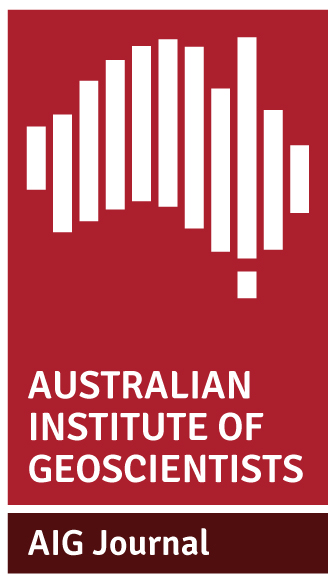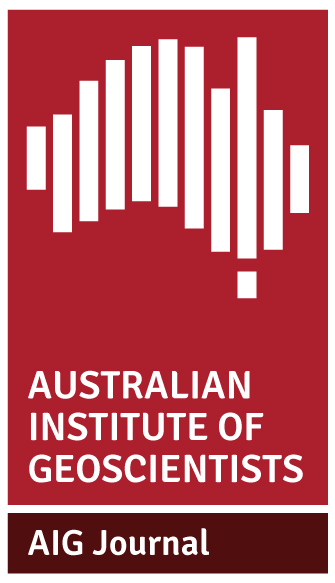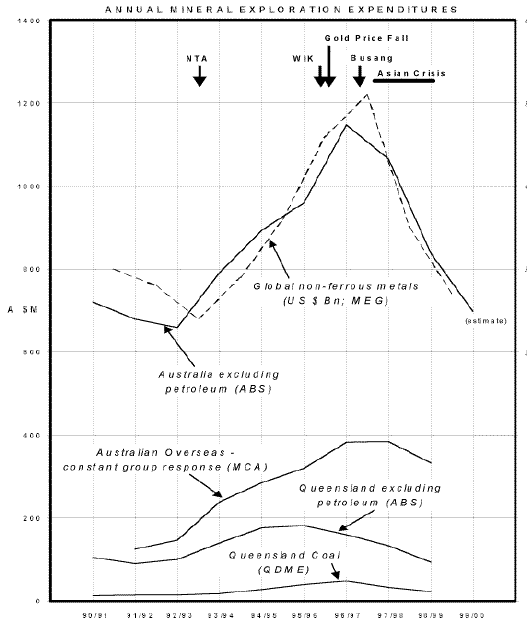
John Anderson, General Manager Exploration – Australia & Africa, MIM Exploration
Click here to download the paper as a PDF
Introduction
The year 2000 presents ongoing challenges to Queensland’s waning mineral exploration industry. Most are related to global or national conditions but some are specific to Queensland.
The challenges confront all participants including the un(der)-employed geoscientists and other staff affected by the halving of the State’s annual exploration expenditure since 1996; the teams retained to make new discoveries that have not been readily forthcoming since 1995, while managing ever-increasing land access restrictions and compliance requirements; the companies considering the value of exploration within their drive for cost efficiencies and shareholder value; and the Government in establishing an attractive framework for re-investment that will benefit the longer term health of the State.
Resource Base
As a mining state Queensland makes an important contribution to Australia’s globally competitive minerals resource base, producing A$7bn worth of minerals each year. This production will grow as the State has seen an unprecedented phase of resource investment over the past few years particularly with $4bn of capital expenditure in the northwest mining-industrial complex.
These investments largely capitalised on established resources discovered near Mount Isa prior to the eighties and on the flurry of discoveries in the Mount Isa Inlier between 1988 and 1992. Although these investments and resources will underpin 10 to 20 years of production, the State needs more discoveries and follow-up investment to underpin the mining industry beyond the first decade of the new millennium.
The Exploration Downturn
The required level of exploration is not being achieved due to a number of economic, statutory and technical impediments. Figure 1 compares exploration expenditure in Queensland with national and global figures. Commodity prices, investor confidence and the need to address Native Title had simultaneous impacts of restricting funding and access for exploration. By comparison with national expenditures, Queensland should have achieved $35m of additional exploration in 1996/7. Since then, the 43% decrease in Queensland expenditure is disproportionate to the 27% national decrease. Expenditure on the State’s coal exploration peaked later in 1997 in keeping with the national profile probably because of a higher proportion of available tenure.
Figure 1. Comparison of annual exploration expenditure in Queensland with national and global exploration expenditure.
Key Drivers and Challenges
The drivers and challenges for mineral exploration are analysed below in a sequence that reflects the basic needs: – funds, access, responsibility and the ability to discover.
Commodity Prices
ABARE recently forecast a short term rise in metal prices over the next two years. There is no certainty in gold price movements. However in the longer term, while the mining industry remains a price taker, the competition through cost efficiencies in operations will expand lower grade reserves and maintain pressure on prices.
Investor Confidence
The resources sector has been reduced by the investment community to about 16% of total market capitalisation in Australia. The principal cause is the investment fashion for abandoning the old production economy of low long term yields for speculation in the new information technology economy. This is compounding a lack of faith in investment returns from exploration, both as equity funding for pure exploration juniors and as corporate investment in exploration divisions.
Company Strategies
In this investment environment, the exploration strategies of major companies are diverse as many companies seek new corporate direction. Some companies, MIM notable among them, maintain exploration teams to support established resource positions in Queensland. Other majors have severely curtailed their metals exploration in the State after long and successful campaigns and have variously established clawback farmouts or database alliances with juniors. Large mostly overseas companies have entered the northwest seeking advanced base metal prospects. There is an accelerated push by many majors to farm into and deep drill ground held by unfunded juniors. Many junior companies are converting to Internet and software businesses in response to investor interest.
It is difficult to quantify the increased brownfields bias with figures variously reported as 25 to 50% of expenditure on near-mine exploration. It is generally accepted that gold discoveries in Australia are becoming more brownfields and driven by larger companies in established belts such as the Yilgarn, Tanami and Tennant Creek. The most recent examples in Queensland are the Mount Wright-Sarsfield discoveries by MIM at Ravenswood during 1992-5, the Vera-Nancy discovery by Normandy-Battle Mountain at Pajingo in 1995 and the emerging discoveries near Cracow by Newcrest-Sedimentary Holdings.
Native Title
The State has the challenge of offering competitive land access that meets the Right to Negotiate requirements of the Federal Native Title Act. There has been a four-year freeze on the granting of Exploration Permits until these procedures are in place. As an interim action, the DME commenced granting “Swiss cheese” EPs underlain by Freehold Titles in June 1999 at a rate of 10 per month. 1200 EPMAs are ungranted, representing over 60% of the area of the State targeted by explorers.
The Native Title (Queensland) State Provisions Amendment Act was passed in 1999 but will not be enacted unless it passes review by both Houses of Federal Parliament. A provisional guide on the intended application procedures was issued by the DME in December. The major issue for explorers is the definition of “Low Impact” exploration, a concept introduced after Industry lobbying to attract a minimum level of consultation for first pass exploration including drilling. Under Federal direction, the definition does not include the clearing of access tracks. This will preclude geophysical surveys and drilling from “Low Impact” conditions in most of Queensland’s prospective terrains. Consultation for “High Impact” permits to ensure that target definition and testing can proceed early in programmes will require time and costs that may be prohibitive in some areas.
Compliance
There is a move away from “self regulation”. For internationally sensitive areas such as indigenous matters and environment, the Federal Government is enacting umbrella legislation that seeks consistent parallel legislation from the states to ensure compliance with treaties, covenants and conventions. The State Government is also applying statutory measures to forefront issues such as safety performance. New codes and regulations will soon be in place for Queensland explorers to implement and manage; i.e.
Regulation of the new Mining and Quarrying Safety and Health Act will be operating by September. It requires companies including explorers to have risk management systems and to nominate responsible Site Senior Executives, with provision for penalties.
The Mining Environmental Protection Policy is nearing final draft. Regulation of prescribed procedures for exploration activities will transfer to the EPA.
A revised model for new Indigenous Cultural Heritage Legislation is available for public comment. The draft includes public site registers and the requirement for cultural heritage management plans.
Issues for the wider mining industry of extended shifts and drug and alcohol testing present challenges for exploration in remote locations. The Industry is particularly seeking improved safety for drill operations through new rod-handling technology.
Public Value
Australia is far more reliant on subsoil resources for its wealth than any of her peers in the twenty wealthiest countries. The support of the broader community is requisite both inside and outside mining regions. Education programmes are widely applied by Industry bodies throughout the country however media reports on persistent overseas incidents of mine pollution are understandably presenting a strong negative image to the average Australian. This presents the Industry in Australia with the challenge of communicating its responsible behaviour, technological leadership and contribution to the nation.
Skills Base
Australia’s pool of professional geoscientists decreased from an estimated 5,300 in 1996 to 2,600 late in 1999. This trend is likely to continue with 12.4% of the State’s registered geoscientists currently unemployed and many more under-employed. Education, employment and human resourcing within our cyclic Industry remain vexed questions. The State’s tertiary institutions are participating in an initiative of the MCA Education Taskforce for the national integration of post-graduate training that will meet the future needs of our Industry.
Ideas and Technology
There has been a paucity of discovery in Queensland since the base metal discoveries driven by new aeromagnetic data through to 1992 and the brownfields gold discoveries to 1995. The expenditure downturn is not the sole reason. The Industry is still challenged by even thin cover. Nearly all of the past greenfields discoveries peak within 60m of the surface. We remain too reliant on magnetics for target selection.
The next step change in models and technology will discover the population of economic deposits that peak below 60m depth. This is overdue, however the reduction in greenfields exploration and research will constrain developments. Queensland, with its pedigree and extensive shallow cover, is an attractive place for the application of these impending advances. MIM, with its new MIMDAS acquisition and interpretation system, is a leader in geophysical targeting technology. Current collaborative research on basin architecture, source rocks and fluid flow in the Isa Inlier will improve 3D geological models that will enable better placement of deep searching technology over targets.
Precompetitive Data
For all the above reasons, the need for Queensland to compete with over 100 countries and many more jurisdictions for the exploration dollar has become even more acute.
In the face of the Australia-wide trend of reducing public expenditures through policies such as “User Pays” and downgrading Geological Surveys, the Queensland Government is addressing the need to maintain data and idea generation through its Prospectivity Plus Initiative. It is in the Industry’s interest to support and advise the DME on stimulating exploration into the next upturn.
Current Activity
Under the freeze on tenure grants, many exploration ideas are being warehoused under applications. Exploration is continuing on granted EPs under relaxed renewal and reduction conditions that ensure some land remains accessible to greenfields exploration.
Progress is being made by companies exploring brownfields gold sites such as Ravenswood, Pajingo, Gympie and Cracow. Base metals exploration is also focussed on minesites including the Isa Valley and Lady Loretta. New results were recently reported from established prospects at Mount Margaret and Mount Garnet. Some greenfields base metal exploration continues on pre1997 EPMs primarily in the districts surrounding the Mount Isa, Century, Cannington and Ernest Henry operations.
The Future
There is potential for another exploration boom in Queensland, but we cannot rely on the State’s pedigree to stimulate it. When the technology investment bubble bursts; when responsible land access becomes possible at reasonable cost for the majority of the State; and when the step change in our ability to explore occurs; then exploration opportunities, efficiencies and funding will increase. Whether these key drivers coincide to maximise the result for the State and its explorers is in many hands.
References
Department of Mines and Energy, 1999. Queensland Minerals and Energy Review 1998-1999.
Department of Mines and Energy, December 1999. Native Title Procedures – Manual for Applicants for Exploration Tenements, Provisional Edition.
J B Were and Son, December 1999. The J B Were Junior Miners Review.
Sheard, S.N. (M.I.M. Exploration Pty Ltd), 1999. Innovation in Geophysics, J B Were Conference (Melbourne).
Directory of Australian Geoscientists, Australian Institute of Geoscientists Web Page, www.aig.asn.au.
Received: March 2000
Published: May 2000
AIG Journal Paper 2000-08, May 2000

